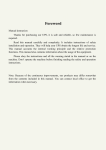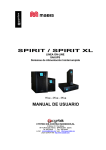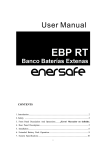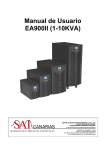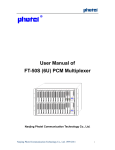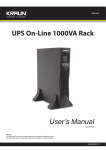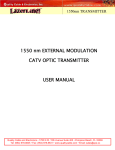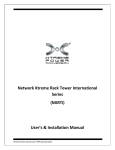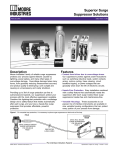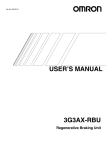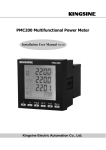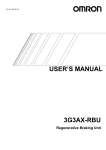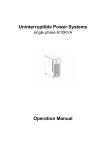Download User Manual
Transcript
Foreword Manual instruction Thanks for purchasing our UPS, it is safe and reliable, so few maintenance is required. Read this manual carefully and completely. It includes instructions of safety installation and operation. They will help your UPS obtain the longest life and service. This manual accounts the internal working principle and the relative protection functions. This manual also contains information about the usage of the equipment. Please obey the instructions and all the warning stated in the manual or on the machine. Don’t operate the machine before finishing reading the safety and operation instructions. Note: Because of the continuous improvements, our products may differ somewhat from the contents included in this manual. You can contact local office to get the information when necessary. Content 1.Summary........................................................ 2 1.1 Introduction .............................................. 2 1.2 functions and characteristics.............................. 2 2.Safety instruction ............................................. 4 2.1 Safety instruction......................................... 4 2.2 Symbols indication......................................... 5 3.Product Introduction ........................................... 6 3.1 The appearance of the product.............................. 6 3.2 The principle of the product............................... 7 3.3 Model ..................................................... 7 4.Installation ................................................... 8 4.1 Unpacking and inspection................................... 8 4.2 Notes ..................................................... 8 4.3 UPS input connection....................................... 8 4.4 UPS output connection...................................... 9 4.5 Long backup external battery connection .................... 9 4.6 Installation ............................................. 10 5.Faceplate display,operation and running ....................... 13 5.1 Faceplate display illumination............................ 13 5.2 Operation ................................................ 16 5.3 Parameter setting......................................... 17 5.4 Parameters inquiring...................................... 21 5.5 Run mode ................................................. 23 6.Maintenance ................................................... 25 7.Troubleshooting and properties of product ..................... 26 7.1 LED indication and warning table.......................... 26 7.2 Troubleshooting .......................................... 28 7.3 EMC standard/Safety standard.............................. 29 7.4 Product Performance....................................... 29 7.5 Communication interface................................... 30 1 1. Summary 1.1Introduction UPS(uninterruptible power supply) is a kind of power supply equipment that provides uninterruptible, high quality and efficient and reliable AC power to the loads, it also has functions of protection and monitoring. The UPS plays a very important role in power supply of computer and its network, communication, finance, electricity, transportation, national defense, college, scientific research institutes and so on. This series of 1KVA-3KVA products are designed as advanced ON-LINE UPS that provide the multiple functions and good performance. 1.2functions and characteristics 1.Advanced IGBT modules are used in our UPS. The electronic components we used can work normally for more than 300,000 hours. 2.Digital control technology with high efficiency and the most reliable controller algorithm design are used to optimize the output parameters of the machine. 3.Self-diagnose before start. It can find potential problems of the UPS in time to avoid any losses. 4.Double conversion on-line topology which makes the output of the UPS a pure sine wave electricity with constant frequency and voltage, low noise and no interruption of the main power fluctuation. It provides more comprehensive and perfect protection for the users’ equipments. 5.No transfer time for the output of the UPS when the main power fails or restores. It meets the high standard and high request of the precise instruments. 6.The bypass function. When UPS meets a fault, it can transfer to bypass with no interruption to supply power to loads and provide alarm. 7.Advanced voltage compensation technology. It makes the input voltage range from 115v to 295v which reduces the battery usage and enhances the adaptive ability against the bad main power variation. 8.The AC input frequency is 50Hz/60Hz. Advanced wide frequency input technology makes the input frequency range wider.When the output frequency is 50Hz, the range of the AC input frequency is 45Hz-55Hz, When the output frequency is 60Hz, the range of the AC input frequency is 55Hz-65Hz.The UPS has a good compatibility with generator. It is suitable for different types of single-phase generators. 9.The advanced PFC( power factor correction)technology on the input of the UPS makes the input power factor more than 0.98. It increases the power efficiency, removes the harmonic noise from UPS to utility, lowers the UPS operational cost. It’s really an economic environmental protection power supply. 10.Intelligent function without surveillance. When main power is on blackout, the UPS will start battery mode to supply power to loads. When battery voltage is low, UPS will protect itself and shut down automatically. When main power restores, UPS will detect main power to determine whether the voltage and frequency are normal. If normal, 2 UPS will turn on automatically to supply power to loads; if abnormal, UPS will start charger to charge the battery. The UPS will not turn on to supply power to loads until the voltage and frequency of the main power restore normally. 11.Cold start function. When there is no main power, UPS can be started by battery pack. It can meet the users’ emergency needs. The cold start function is quite strong. UPS can be cold started under the full load situation. 12.UPS protection function: When the main power input/output voltage is too high or too low, overload, short-circuit, inverter temperature is too high, low voltage and overcharge of battery, network surge and so on, UPS has a protection function. 13.Rack-Tower conversion LCD design. No matter what angel to watch the display, only press the key slightly can meet your perspective needs. The content displayed on the interface is rich. The capacity of the loads and the battery can be saw directly and the FLASH pictures and fan rotating icon can be displayed when charging. So it is easy to know it’s operation. When UPS fails, it can show the fault code, the machine can be maintained as soon as possible by inquiring fault code table. 14.The UPS can communicate with the computer with intelligent UPS monitoring software through the RS232 interface. All the parameters clearly display on the communication interface. Computer can control multiple functions of the UPS directly. 15.Via internal or external SNMP adapter, UPS can go on internet and provide the latest information and power messages. You can monitor and manage the UPS status through all kinds of network management system. 16.Convenient USB communication. You can see the operation of the machine completely. Even if the RS232 interface is occupied or connected at the same time, it will automatically switch to USB connection. 17.ECO function can help you save electricity. When the input mains power is in a fixed range, the loads is supplied with power by mains power directly, the inverter is on waiting; when input mains power is abnormal, it transfers to inverter to supply power to loads at once. 18.In order to ensure the power of the important loads can last for a long time, you can plug the important loads into the second power down socket. When the battery voltage is below the predetermined value, only the first cut-off power socket is broken off, the second power down can keep on supplying power until the battery voltage reaches protect point and shut down. 19.Adopt international standard rack-mounted size. Whether you want to put it on the office desk or in the rack-mount as a system to manage, It can present your personal style with corresponding components. 3 2. Safety instruction Abstract This chapter mainly introduce the safety marks and notes of 1KVA-3KVA series on-line UPS. Read this chapter carefully before operating on the equipment. 2.1 Safety instruction There is dangerous voltage and high temperature inside the UPS. During the installation, operation and maintenance, please abide the local safety instructions and relative laws, otherwise, it will result in personnal injury or equipment damage. Safety instructions in this manual act as a supplementary for the local safety instructions. Our company will not assume the liability that caused by disobey of safety instructions. Please note the following: 1. Don’t use the UPS when the actual load exceeds the rated load. 2. There are high-capacity batteries in the standare type UPS. You mustn’t open the enclosure or it will lead to electric shock. If it needs internal maintenance or battery replacement, please send it to the designated site. 3. Internal short-circuit of the UPS will cause electric shock or fire. So don’t place the containers equipped with liquid on the top of the UPS so as not to cause danger of electric shock and so on. 4. Don’t put the UPS in a place with high temperature or humidity as well as the corrosive gas, much dust. 5. Keep good air circulation between in-vent on front panel and out-vent on back panel. 6. Avoid direct sunlight or near heat-dispensed objects. 7. In case that the smoke appears on the UPS, please cut off the power as soon as possible and contact the dealer service site. 4 2.2 Symbols indication The safety symbols cited in this manual are shown in table 1-1, which are used to inform readers of safety issues that should be obeyed when installation, operation and maintenance. Safety Symbol Indication Attention Static discharge sensitive Electric shock There are three levers of safety grade: Dangerous, Warning and Attention. The remark is on the right side of the safety symbol, the detailed comments is behind, shown as following: Dangerous Indicate risk of serious injury or death or seriously damage the equipment Warning: Indicate risk of serious injury or damage the equipment. Attention: Indicate risk of injury or damage the equipment. 5 3. Product Introduction 3.1 The appearance of the product Fig 1 Front Panel view Fig 2 1KVA Rear Panel view Fig 3 2KVA/3KVA Rear Panel view 6 3.2 The principle of the product Fig 4 UPS Principle Diagram 1. input filter: Complete filtering the input AC utility power to provide the clean power for UPS. 2. AC/DC converter: Convert the filtered AC mains to DC and boost the DC for DC/AC inverter. 3. DC/DC booster: When the UPS works in battery mode, the circuit boosts the DC for DC/AC inverter. 4. DC/AC inverter: Convert the boosted DC to stable AC output. 5. Bypass: When overload or failure of inverting happen in the UPS, it transfers to bypass mode to supply power to loads. 6. Charger: Standard unit provides 1A; long backup unit provides 7A/14A. 7. Battery: Sealed Lead Acid Battery. 8. Output filter: Complete filtering the output of the UPS to provide the clean power for loads. 3.3 Model UPS sort MODEL NO Remark Internal 1A charger, 2 high-rate 1KVAS 9AH batteries Internal 1A charger, 4 high-rate 2KVAS Standard unit 9AH batteries Internal 1A charger, 2 high-rate 3KVAS 9AH batteries ★internal 7A/14A charger, 1KVAH external 24V battery ★internal 7A/14A charger, 2KVAH Long backup unit external 48V battery ★internal 7A/14A charger, 3KVAH external 72V battery Notice:long backup unit can choose two chargers connected in parallel, the charger current is 14A. 7 4. Installation 4.1 Unpacking and inspection 1. Unpacking the UPS and check that whether it’s damaged during the transportation. If damaged or some parts missing, don’t start the machine and inform the carrier and franchiser. 2. Check the annex (please consult Appendix Table 1). 3. Check if the equipment is just what you wanted to purchase. You can affirm through inspecting the model number on back panel of the equipment. 4.2 Notes 1. Please place the UPS in a clean, stable environment, avoid the vibration, dust, too humidity, flammable gas and liquid, corrosive. 2. The ambient temperature around UPS should keep in a range of 0℃~ 40℃. If UPS works above 40℃, it is required that the rated value of the largest load decreases 12% while the temperature increases the 5℃ every time. The highest temperature cannot be more than 50℃ when UPS works. 3. UPS should be placed in a sufficiently ventilated place. 4.3 UPS input connection Connect the UPS to the mains by input power cable which is equipped with the UPS. Fig 5 Input Connection 8 4.4 UPS output connection Fig 6 output connection 4.5 Long backup external battery connection Fig 7 battery connection 9 4.6 Installation 4.6.1 Plastic base installation ① two plastic base brackets intercross as following Figure ② flatten it after intercrossing Fig 8 1KVA(S/H) plastic base assembly ③ 2KVA/3KVA(S/H) plastic base assembly is similar to 1KVA(S/H), the difference is that there is a 1U plastic base bracket extended board for 2KVA/3KVA(S/H)。 (A) (B) (C) (D) Fig 9 2KVA/3KVA(S/H) plastic base bracket 10 4.6.2 Cabinet installation bracket assembly ① screw A, screw B, two M4 screws ( symmetrical on both sides, a total of four) Fig 10 Cabinet installation bracket assembly ② cabinet installation bracket screw hole A, screw hole B are respectively corresponding to two screws (symmetrical on both sides, a total of four). Fig 11 Cabinet installation bracket Fig 12 Cabinet installation bracket assembly ③ screw the two M4 screws described as Fig 10 ( symmetrical on both sides, a total of four). Fig 13 Cabinet installation bracket assembly 11 4.6.3 Tower/Rack assembly Fig 14 Tower-mounted assembly Fig 15 Rack-mounted assembly Warning: ★ Before installing battery, make sure that UPS and breaker are all turned off. Remove all your metallic adornment such as finger ring, watch, and so on before connecting battery. ★ No anti-connection or short circuit between the battery anode and cathode forever. Red cable connect with battery anode “+” and black cable connect with cathode “-”. ★ Please use the screwdriver with insulating handle. Do no lay the tools or metallic goods on the battery. Notice: ★When using the external battery, It is best to use external battery cable which matches with the equipment. ★When connecting load to UPS, first turn off load and then connect the power cable and finally turn on load one-by-one. ★Inductance loads such as motor, fluorescent lamp, copy cat are strictly prohibited connecting to UPS to avoid damage. ★Plug UPS on the special socket with over-current protection, the power socket that used should be connected with ground wire. ★UPS is likely to have output voltage no matter whether the power input cable is plugged in mains input socket. If you wish UPS have no output, first break off the switch and then cancel the mains. ★When connect laser printer, select the capacity of UPS according to the UPS start power because the startup power is higher. 12 5. Panel display, operation and running The operation is simple, operators only need to read the manual and follow the operation instructions listed in this manual without any special training. 5.1 Faceplate display illumination 5.1.1 Keys function Fig 16 front panel keys instruction ON/OFF key ( + ) Press and hold this key for more than half a second to turn on or turn off the UPS. ROTATE key ( + ) Press and hold this key for more than 2 seconds to rotate LCD in any mode. SELF-TEST/MUTE key ( + ) Press and hold the key for more than 1 second in mains mode or economical mode: UPS runs the self-test function. Press and hold the key for more than 1 second in battery mode: UPS runs the mute function. INQUIRING key or Non-functional setting mode: Press and hold the key for more than half a second (less than 2 seconds): Indicate the items of the LCD item section orderly. for more than 2 seconds: Circularly and orderly Press and hold display the items every 2 seconds, when press and hold the key for some time again, it will turn to output status. Functional setting mode: Press and hold the key for more than half a second (less than 2 seconds): Select the set option. Function setting key Non-functional setting mode: Press and hold the key for more than 2 seconds: Function setting interface. Functional setting mode: Press and hold the key for more than half a second (less than 2 seconds): Affirm the set option. 13 5.1.2 The description of LED display lamp functions Warning red LED is on: UPS is fault and has no output. For example: Overload beyond the allowed time, inverter fault, BUS fault, over temperature fault etc. Bypass yellow LED is on: UPS is alarming. For example: Bypass mode supply power and etc. Battery yellow LED is on: UPS is alarming. For example: Battery mode supply power and etc. Inverter green LED is on: UPS is normally powered by mains or ECO mode or battery mode. After starting the UPS, the four LEDs will light and go out one-by-one. It circulates several times until starting the UPS successful. NOTE: As to the LED indication in different modes, please refer to the LED lamps/display panel and warning table. 5.1.3 LCD display functions When UPS is tower-mounted, the LCD displays as following Fig A. Press and hold the ROTATE key for more than 1 second, the display will begin to rotate which matches with the rack-mounted configuration. LCD displays as following Fig.B. 14 (B) Rack-mounted placement (A) Tower-mounted placement NOTE: Press and hold the ROTATE key for more than 2 seconds, Fig.A and Fig.B will transfer to each other. LCD display comprises numerical value section, capacity graphics section, fan-status graphics section and charger-status graphics section. Numerical value section-display the corresponding numerical value of inquiring items(output, load, temperature, input, battery), for example, as the graphics shows above, the output voltage is 220v, the output frequency is 50Hz. Capacity graphics section-display the capacity of the battery and load. Every pane represents 20%capacity. As graphics showed above, the capacity of the battery is 80%-100%( 5 panes), the load reaches 40%-60%(3 panes). When UPS is overload, the icon will flash, when capacity of battery is too low or disconnected, the icon will also flash. Fan-status graphics section-display if the fan works normally. When the fan works normally, it will show the dynamic fan blades rotating; when the fan works abnormally, the icon will keep on flashing and alarm. Charger-status graphics section-display the status of the charger. When charger works normally, the corresponding icon will vary dynamically and orderly, just as Graphics (1); (1) when charger works abnormally, the icon will flash in a whole, as Graphics(2): (2) 15 When UPS is in battery mode, the number of the icons of the charger-state section will vary according to the changeable capacity of the battery (pane). For example, there are five panes in Fig.A,(as the right picture of the Graphics(3) shows), so the corresponding number of icons is five rows(as the left picture of the Graphics(3) shows),, followed by this rule, (3) 5.2 Operation 5.2.1 Start up operation Turn on the UPS in line mode ① Once mains power is plugged in, the UPS will charge the battery, at the moment, LCD shows that the output voltage is 0, which means UPS has no output. If it is expected to have output of bypass, you can set the bps “ON” by LCD setting menu. ② Press and hold the ON/OFF key for more than half a second to start the UPS, then it will start the inverter. ③ Once started, the UPS will perform a self-test function, LED will light and go out circularly and orderly. When self-test finishes, it will come to line mode, the corresponding LED lights, UPS is working in line mode. Turn on the UPS by DC without mains power ① When mains power is disconnected, press and hold the ON/OFF key for more than half a second to start UPS. ② The operation of UPS in the process of start is almost the same as that when mains power is in. After finishing the self-test, the corresponding LED lights and UPS is working in battery mode. 5.2.2 Turn off operation Turn off the UPS in line mode ① Press and hold the ON/OFF key for more than half a second to turn off the UPS and inverter. ② After UPS shutting down, LED go out and there is no output. If output is needed, you can set bps “ON” by LCD setting menu. Turn off the UPS by DC without mains power ① Press and hold the ON/OFF key for more than half a second to turn off the UPS. ② When turning off the UPS, it will do self-testing firstly. LED light and go out circularly and orderly until there is no display on the panel. 16 5.2.3 UPS self-test/mute test operation. ① When UPS is in line mode, press and hold the self-test/mute key for more than 1 second, LED light and go out circularly and orderly. UPS comes to self-test mode and tests its status. It will exit automatically after finishing testing, LED resume. ② When UPS is in battery mode, press and hold the self-test/mute key for more than 1 second, the buzzer stops beeping. If you press and hold the self-test/mute key for one more second, it will restart to beep again. 5.3 Parameter setting UPS has setting function. It can run the setting on any mode. After setting, it will become effective at once when meets some standards. The set information can be saved only when the battery connected and normally turning off the UPS. The operation of setting is as following: 5.3.1 ECO mode setting ① Enter the setting interface. Press and hold the function setting for more than 2 seconds, then come to setting interface, key the letters ECO will flash as following: ② Enter the ECO setting interface. Press and hold the function setting for more than half a second(less than 2 seconds), then come key to setting interface of ECO, at this time, the letters “ECO” will light for a long time. The “ON” below the ECO will flash. Press for more than half a second (less and hold the inquiring key than 2 seconds) to determine whether the ECO function is used or not. If used, the corresponding word is “ON”, if not, the word is “OFF”. It can be determined by yourself. 17 ③ Confirm the ECO setting function. After selecting ON or OFF, press for more than 2 seconds. Now, and hold the function setting key the ECO setting function is completed and the “ON” or “OFF” below the “ECO” will light without flash. ④ Exit from the setting interface. Press and hold function setting for more than 2 seconds, exit from the setting interface key and turn to main interface. 5.3.2 Bypass output setting ① Enter the setting interface.Press and hold the function setting key for more than 2 seconds, then come to setting interface, Press for more than half a and hold the function setting key second(less than 2 seconds), select the function setting, choose the bypass output interface, at the moment, the letters “bPS” will flash as following: 18 ② Enter the Bypass output setting interface.Press and hold the for more than half a second(less than 2 function setting key seconds), then come to setting interface of bPS, at this time, the letters “bPS” will light for a long time. The “ON” below the bPS for more than half will flash. Press and hold the inquiring key a second (less than 2 seconds) to determine whether the bPS function is used or not. If used, the corresponding word is “ON”, if not, the word is “OFF”. It can be determined by yourself. ③ Confirm the Bypass output setting interface. After selecting ON or for more than 2 OFF, press and hold the function setting key seconds. Now, the bPS setting function is completed and the “ON” or “OFF” below the “bPS” will light without flash. ④ Exit from the setting interface. Press and hold function setting for more than 2 seconds, exit from the setting interface key and return to main interface. ⑤ After setting bPS as ON, when mains power plugged in without turning on the UPS or no mains power plugged in, there is bypass output but no power down backup function. 5.3.3 Output voltage setting (optional function) ① Enter the setting interface.Press and hold the function setting key for more than 2 seconds, then come to setting interface, Press for more than half a and hold the function setting key second(less than 2 seconds), select the function setting, choose the output voltage setting interface, at the moment, the letters “OPU” will flash as following: 19 ② Enter the output voltage setting interface Press and hold the for more than half a second(less than 2 function setting key seconds), then come to setting interface of output voltage OPU, at this time, the letters “OPU” will light for a long time. The numerical value below the OPU will flash. Press and hold the for more than half a second (less than 2 seconds), inquiring key select the numerical value in accordance with “OPU” function. The provided voltages are 208v, 220v, 230v, 240v you can choose anyone by yourself (The default is 220v). ③ Confirm the output voltage setting interface After selecting for numerical value, press and hold the function setting key more than 2 seconds. Now, the OPU setting function is completed and the numerical value below the “OPU” will light without flash. ④ Exit from the setting interface. Press and hold function setting for more than 2 seconds, exit from the setting interface key and return to main interface. 20 NOTE: When setting the output voltage ,you’d better cut off the load of the UPS first. 5.4 Parameters inquiring for more than half a Press and hold the inquiring key or second(less than 2 seconds) to inquire about items. The inquired items include input, battery, output, load, temperature. The displayed items on LCD screen are showed as following: Output:Display the output voltage and output frequency of the UPS. As the following graphic shows, the output voltage is 220v, the output frequency is 50Hz. Load: Display the numerical value of the active power(WATT) and apparent power(VA) of the load. For example, as the following graphics shows: the WATT of the load is 100w, VA is 100VA (when disconnect load, it is a normal phenomenon to show a small numerical value of WATT and VA). Temperature: Display the temperature of the inverter in the UPS. As the following graphics shows: the temperature of the inverter is 37℃. 21 Input: Display the voltage and frequency of the input. As the following graphics shows: the input voltage is 210v, input frequency is 49.8Hz. Battery: Display the voltage and capacity of the battery ( determined by type). As the following graphics shows: the battery voltage is 28v, the capacity of battery is 100 % (the capacity of battery is approximately reckoned according to the battery voltage). 22 Press and hold the inquiring key for more than 2 seconds, LCD begins to display the items circularly and orderly which transfer to another every 2 seconds. Press and hold the key for some time again, it will return to output status. 5.5 Run mode 5.5.1 Bypass mode LED indications on front panel in bypass mode are as following: Bypass yellow LED is on,the buzzer beeps once every 2 minutes . The warning red LED is on when beeping. LCD displays are according to the exact load and battery capacity. Turn to bypass mode under the following two conditions: ① Turn off the UPS in line mode while start the bypass output. ② Overload in line mode. NOTE: When UPS is working in bypass mode, it has no back up function. 5.5.2 Line mode LED indications on front panel in line mode are as following: the inverter green LED is on . When input AC mains is in line with the working conditions, UPS will work in line mode. 5.5.3 Battery mode LED indications on front panel in battery mode are as following: both the inverter green LED and battery yellow LED are on, the buzzer beeps once every 4 seconds. The warning red LED is on when beeping. When the mains power down or instable, UPS will turn to battery mode at once. Continuously working on battery mode can last for 20 hours depending on the battery volume and the load. If battery discharge for 20 hours and the load is lower than 10% of rated power , the UPS will alarm for half an hour and then shutdown to protect the batteries. 23 5.5.4 ECO mode LED indications on front panel on ECO mode are as following: both the inverter green LED and bypass yellow LED are on. When the input mains meets the input range of the ECO mode and start the ECO function, the UPS will works on ECO mode. If input AC mains exceeds the range of ECO several times in a row in a minute but stays in inverting input range, UPS will work on inverting mode automatically. 5.5.5 Fault mode LED indications on front panel in fault mode are as following: Fault mode(LCD interface on which the fault code display) When UPS has fault, the fault LED lights and the buzzer beeps. UPS will turn to fault mode when overload fault, inverting fault and over-temperature fault happen. UPS cuts off the output and LCD display fault codes. At the moment, you can press the mute key to make the buzzer stop beeping temporarily to wait for maintenance. You can also press the ON/OFF key to shut down the UPS when confirm that there is no serious fault. NOTE: As for corresponding information of the fault code, please refer to Fault Code information Table in Appendix. NOTICE: ★The following process must be performed if UPS is connected with generator: ★First turn on generator, after it runs stably connect output power of generator to UPS input terminal, then turn on UPS. After UPS turned on, please connect load one-by-one. ★ It is recommended that the generator capacity is as twice as UPS rated capacity ★ You’d better not use the ECO mode when the quality of the input AC mains is not good。 24 6. Maintenance Only minimum maintenance is required for this series of UPS. The battery is sealed lead acid maintenance free. It only needs to be kept charging to obtain the expected life. Whether it is started or not, the UPS would charge batteries once it is connected to mains and provide protection for over-charging and deep discharging. 6.1 Battery maintenance 1 It is recommended that the batteries are manually charged or discharged. once every three or four months if UPS has not been used for a long time or the power is long-term uninterruptible. The battery will be fully discharge to low-voltage protection shutdown. Then it needs to be fully charged once. 2. In high temperature area, batteries should be manually charged and discharged once every two months. The process is the same as that said above. 3. Under normal circumstances of using, the battery working life is three to five years. If you find that the battery do not act well such as obviously shortening of backup time, too much imbalance on battery voltage so on, the battery should be replaced as soon as possible, which must be performed by qualified personnel. 4. When replace battery, it is recommended to change battery all together instead of changing separately. NOTICE: ★Before replacing batteries, first please turn off the UPS and break off the mains. Remove your metallic adornment such as finger ring, watch and so on. ★When replace batteries, please use the screwdriver with insulating handle. Do not lay the tools or metallic goods on the battery.。 ★Never revert or short circuit between the battery anode and cathode.。 25 7. Troubleshooting and performance of product The following messages are the information that users would find on UPS when it meets some problems. Users can judge if the fault is caused by external factors and know how to deal with it by making full use of the information. 1. Fault indicator on, indicates that the UPS has detected some fault. 2. Buzzer beeps, indicates that UPS need to be paid attention to, if beeps for a long time, it means that there is something wrong with the machine. 3. If you need help, contact our service department, the following messages should be provided for analysis: ◆UPS MODEL NO. and SERIAL NO. ◆Date of fault happened ◆Detailed description statements on panel) of the problem 7.1 LED indication and warning table Appendix1:Fault Codes Fault causation Fault Code Bus Fault 00-19 Inverter Fault 20-39 Over Heat 40-44 Output short circuit 45-49 Overload 50-54 Output Relay Fault 55-59 Input NTC Fault 60-64 Auxiliary Power Fault 65-69 Input Fuse Fault 70-74 Others 99 26 (include indicator Appendix 2:The corresponding working status of indications NO Working status 1 Line mode Normal voltage High/low voltage protection, turn to battery mode Battery mode 2 Normal voltage 3 4 Indication Nor Bat Bps Fan ● ● ★ ● ● ★ Bypass mode ● ● ★ ★ Once every four seconds ★ Once every four seconds ★ 7 8 Fault mode Once every four seconds Once every four seconds Six times Overload in line mode, protection 6 Once every four seconds Once per second Once every two minutes ★ Output overload protection Overload warning ● in line mode, Overload warning in battery mode Overload in battery mode, protection Overload warning in bypass mode Fan fault (fan icon flash) Once every four seconds ★ Power up or start 5 Remarks None ● Battery Voltage ★ abnormal warning ● Bypass mode Main AC Normal voltage in ● bypass mode Main AC high voltage warning in bypass mode Main AC low voltage warning in bypass mode Battery disconnect warning Inverting mode Warning ● Eliminate after starting the UPS Affirm if the battery switch is closed Affirm if the battery switch is closed Affirm if the battery is connected well ★ Twice per second ● Long beeps Remove the less important loads Remove the less important loads ● ● ★ Twice per second Remove the less important loads ● ● ● Long beeps Remove the less important loads ▲ ▲ ● ★ ▲ ★ ● 27 Once every 2 Remove the less seconds important loads Once every 2 Check if the fan is seconds blocked by object. If display fault code and icon lights, contact for Long beeps maintenance when you can’t deal with it by yourself. ● _indicator lights for a long time ★ _indicator flashes ▲ _the status of indicator depends on other conditions Note: When UPS has fault, it is convenient for you to know the working status of UPS and the exact information about the fault promptly by referring to the two tables listed above. 7.2 Troubleshooting When the fault occurs, firstly, perform troubleshooting by referring to the troubleshooting table. If the fault still exists, please contact the franchiser. Fault Cause Solution The voltage or frequency of mains power exceeds UPS input range UPS is working in battery mode, save disk and close the programs, make sure AC mains voltage and frequency is in the normal range Anti-connection of mains live and neutral Re-connect the input power cable and make a correct connection Battery capacity indicator flashes Battery low voltage or battery disconnected Check UPS battery, connect battery well, if battery damaged, replace it Mains normal, but UPS has no input UPS input breaker open circuit Press the breaker for reset Battery not fully charged Keep UPS connecting with mains power for more than 8 hours, recharge battery UPS overload Check the usage of loads, remove some redundant devices Battery aged When replace battery, contact franchiser to get battery and relative assembly Short holding time Press and hold the ON key for more than 1s to start UPS UPS has no battery connected or battery voltage low and too many loads connected Connect UPS battery well, if battery voltage low, please turn off UPS and take off some loads, then start UPS Fault occurs inside UPS Contact supplier for servicing Charger doesn’t work normally or battery aged Contact supplier for servicing The “INPUT” letters on LCD display section flashes Short back up time UPS doesn’t startup after pressing the ON key The icon of charger status on LCD display flashes and buzzer beeps once per second 28 7.3 EMC standard/Safety standard ◆Our product are manufactured according to the following EMC international grade standard and has passed the CE authentication: EMC standard number Safety standard number IEC62040-2 IEC61000-4-2 IEC61000-4-3 IEC61000-4-4 IEC61000-4-5 IEC62040-1 GB4943-2005 7.4 Product Performance 7.4.1 Electric performance Model Rated capacity 1KVAS 1KVAH 800W/1000VA 3KVAS 3KVAH 2400W/3000VA Single phase and earthing 115±5VAC-295±5VAC 45Hz-55Hz@50Hz/55Hz-65Hz@50Hz ≥0.98 setting rated output voltage ±20VAC 186VAC-252VAC input Voltage range Frequency Power factor ECO range Bypass range input Output style Rated voltage Power factor Voltage precision Output Line mode Frequency output Battery mode Crest ratio Transfer time Battery mode Single phase and earthing 208/220/230/240VAC 0.8 ±2% 1、When input frequency is in the range,the output frequency is the same as that of input. 2、When input frequency is out of the range,the output frequency of output is (50/60±0.2)Hz (50/60±0.2)Hz 3:1 mains←→battery =0ms mains←→bypass <4ms 108%±5%<load≤150%±5% >30s cut off output and warn, 150%±5%<load<200%±5% > 300ms cut off output and warn Overload capacity Line mode efficiency 2KVAS 2KVAH 1600W/2000VA mains battery ECO 108%±5%<load≤150%±5% > 30s transfer to bypass and warn 150%±5%<load<200%±5% Full load≥87% >300ms transfer to bypass and warn Full load≥88% Full load≥85% Full load≥94% 29 Input battery voltage Internal battery battery 24VDC 2 72VDC 72VDC 6 12V/9AH high-rate sealed lead acid maintenance free battery ( only refers to standard UPS) Full load≥5min(only refers to standard UPS),As for long backup UPS, the backup time is determined by the capacity of battery. 1 7/14 1 7/14 1 7/14 Internal battery type Backup time Charge current(A) 24VDC 48VDC 4 48VDC NOTE: The rated output voltage has been already provided. The function of setting the rated output voltage by LCD menu is an optional. ◆ Work Environment Model 1KVA-3KVA series Temperature 0℃~40℃ Relative 0~95% non-condensing Altitude <1500m. when >1500m, lower the rated power for use Store temperature -25℃~55℃ ◆ Mechanical Specification Model 1KVAS 1KVAH Dimension W*D*H (mm) 440*380*86.5 3KVAS weight(kg) 12/14.5 7/9.5 2KVAS 2KVAH Net weight/Gross 21.5/24.3 440*520*131 11.5/14.3 26/28.8 3KVAH 11.7/14.5 7.5 Communication interface 7.5.1 RS232 communication interface This UPS provides a standard DB9 communication interface on its rear panel, the definition of the pins is as following: 30 7.5.2 RS232 cable specifications When connecting the UPS with PC by RS232 cable, it needs to use the standard RS232 cable, the detailed cable NO. are as following: PIN 1(hole)to computer serial port PIN 2(needle)to UPS serial port 2 2 3 3 5 5 7.5.3 Optional communication interface ① USB communication interface USB communication interface: Install the intelligent monitoring software UPSilon2000 which is equipped with the UPS. Then it can achieve the communication with monitoring device directly. When RS232 and USB are provided, only one of them will be chosen and USB is preferred. ② Intelligent slot The following intelligent cards can be installed into the intelligent slot of the UPS: intelligent USB card, intelligent SNMP card and intelligent dry contact card. Support the hot plug and play. Any card of them can be used according to users’ requirements. a) Intelligent USB card: Use the monitoring function of the USB interface system to monitor and manage the power source of the UPS. b) Intelligent SNMP card: When connecting to the internet by SNMP card, it communications with the monitoring computer to monitor power source of the UPS from far end. c) Intelligent dry contact card: Use the monitoring function of the dry contact interface system to monitor and manage the power source of the UPS. NOTE: Remove the cover before installing the optional accessories. The operating instruction of the UPSilon can be acquired from the CD. As for the operating instructions of the intelligent USB card, SNMP card and dry contact card, please refer to the relative special instructions. 31 CONTENTS 1. Introduction ...............................................................................................................2 2. Safety ......................................................................................................................2 3. Front Panel Description And Operations ..............................................................5 4. Rear Panel Description ...........................................................................................6 5. Installation.................................................................................................................8 6. Extended Battery Pack Operation ........................................................................10 7. System Specifications ............................................................................................12 1 1. Introduction The battery pack Rack/Tower Series of Products has been designed to provide quality power protection at outstanding prices. The External Battery Packs have been designed with removable battery cartridges and individual chargers for maximum value. 2. Safety IMPORTANT SAFETY INSTRUCTIONS: It is imperative to SAVE THESE INSTRUCTIONS! NOTE: Please read this manual before installing the 1KVA-3KVA battery pack, model 1KVA battery pack, 2KVA battery pack, 3KVA battery pack as it provides important safety information. Please follow the instructions contained herein during installation, troubleshooting and maintenance of the battery packs. If questions exist after reading this manual, please contact the Customer Service or Technical Support. This Symbol indicates “ATTENTION” This Symbol indicates “RISK of Electrical Shock” Φ This Symbol indicates “Alternating Current Supply Phase” This Symbol indicates “Alternating Current Supply” This Symbol indicates “Direct Current Supply” This Symbol indicates “Equipment Grounding Conductor” CAUTION! It is required, when using the AC cords attached to the Battery Packs, that a two pole, three wire grounded AC wall outlet be utilized. The receptacle and branch protection must comply with local electrical codes. 2 CAUTION! These Battery Packs must be installed and operated in a temperature controlled environment (0-40 degrees Celsius). Place the Battery Packs and UPS in a location or area that will provide maximum air flow (100mm sides and back). WARNING: These Battery Packs contain potentially hazardous voltages. Do not attempt to disassemble the Battery Pack beyond the battery replacement procedure. A user should never attempt to service a Battery Pack, as they contain no user serviceable parts. Battery replacement and repairs must be performed by Power or Qualified Service Personnel, only. WARNING!! Risk of Electrical Shock exists. Components contained within the Battery Packs may be energized from the battery even when the AC input is disconnected. De-energization of the Battery Packs CAUTION! To de-energize the Battery Pack: 1. If the UPS is on, press and release the “Off” button. 2. Disconnect the UPS and the Battery Packs from the wall outlets. 3. Turn off the DC breaker on the rear panels of the Battery Packs. 4. Disconnect the battery cable from the rear panel of the UPS. 5. For complete Battery Pack de-energization, disconnect the batteries. WARNING: Qualified Service Personnel ONLY must perform the Installation and Servicing of these Battery Packs. Please Note: Each UPS has different DC bus voltages and each UPS is designed to mate with a specific Battery Pack. Only use the specific Battery Pack, stated below, with its appropriate UPS. These Battery Packs MUST be operated with their respective UPS models, see the table below: 3 1KVA battery pack 2KVA battery pack 3KVA battery pack 24 VDC 48 VDC 72 VDC 1KVAS 2KVAS 3KVAS Model UPS Model Warning! If an incorrect battery pack is connected to a UPS, a severe electrical hazard may happen. Please always verify the Battery Pack model and the correct DC bus voltage before connection PLEASE SAVE THE PACKING MATERIALS! CAUTION: It is very critical to connect the correct voltage battery pack with the UPS intended. 1KVA battery pack is for 1KVA UPS 2KVA battery pack is for 2KVA UPS 3KVA battery pack is for 3KVA UPS CONNECTING THE INCORRECT BATTERY PACK TO THE UPS MAY RESULT IN DAMAGE TO THE UPS AND/OR BATTERY PACK, AND THE WARRANTY WILL BE VOIDED. All battery packs have a different DC voltage configuration intended only for the UPS listed above. 4 3. Front Panel Description And Operations Figure 1 Front panel LED Description The Charging LED GREEN indicates that the battery charger in the External Battery Pack is charging normally with the AC power cord attached to the Battery pack. The Battery Test LED GREEN indicates that the DC output of the External Battery Pack is normal. To perform the Battery Test. • switch on the breaker on the rear of the Battery Pack • press the Battery Test Button on the front panel of the Battery Pack • the DC output from the Battery Pack is normal when the Battery Test LED is on Before connecting Battery Pack, test each Battery Pack to assure proper operation. 5 4. Rear Panel Description 1KVA Battery pack rear panel Figure 2 1KVA Battery pack rear panel 2KVA/3KVA Battery pack rear panel Figure 3 2KVA/3KVA Battery pack rear panel 6 1. The DC Circuit Breaker connects and disconnects the DC bus voltage from the Battery pack to the UPS. The DC Circuit Breaker will disconnect in the event of an over-current condition. 2. The External Battery connector is for Daisy Chaining additional Battery Packs and/or connecting to the UPS. 3. The AC Inlet is for connecting the input power cord to operate the Charger. 4. The Input AC Breaker will disconnect in the event that the Internal Charger draws excessive current. 5. The External Battery cable is for connecting the Battery Pack to the UPS or Daisy Chaining additional Battery Packs. CONNECTING THE BATTERY PACK TO AN AC POWER SOURCE Battery Packs require 220V input voltage, each socket permits only three battery packs’ input power cord to be plugged in. 1. Connect the Battery Pack input power cord into the AC inlet on the Battery Pack. 2. Insert the “plug” end of the input power cord for the Battery Pack into the AC wall outlet. Only utilize a two-pole, three-wire grounded receptacle. Do not use additional cords, outlet strips or surge strips. 3. Switch on the DC circuit breaker. At this point, the UPS will need to be started. Please refer to the recommended process in the UPS User’s Manual. NOTE: If connecting more than one Battery Pack please refer to the Daisy Chaining section. CHARGING THE BATTERY If the Battery Packs are plugged into an AC source and properly installed, the internal batteries will be charged when acceptable voltage is provided. Battery Packs must be charged for a minimum of 6 hours before use. NOTE: If the Battery Pack is going to be out of service or stored for six months or above, the batteries must be recharged for at least 36 hours every six months. 7 5. Installation Plastic base installation ① two plastic base brackets following Figure Figure 4 ② flatten it after intercrossing intercross as 1KVA Battery Pack plastic base assembly ③ 2KVA/3KVA Battery Pack plastic base assembly is similar to 1KVA Battery Pack, the difference is that there is a 1U plastic base bracket extended board for 2KVA/3KVA Battery Pack. Figure 5 2/3KVA Plastic base (A) Figure 6 8 2/3KVA Plastic base (B) Figure 7 2/3KVA Plastic base (C) Figure 8 2/3KVA Plastic base (D) 2KVA/3KVA Battery Pack Cabinet installation bracket assembly ① screw A, screw B, two M4 screws ( symmetrical on both sides, a total of four) Figure 9 Cabinet bracket assembly ② cabinet installation bracket screw hole A, screw hole B are respectively corresponding to two screws (symmetrical on both sides, a total of four). Figure 10 Cabinet installation bracket Figure 11 Cabinet installation bracket assembly ③ screw the two M4 screws described as Fig 9 ( symmetrical on both sides, a total of four). 9 Figure 12 Cabinet installation bracket assembly Tower/Rack assembly Figure 13 Tower-mounted assembly Figure 14 Rack-mounted assembly 6. Extended Battery Pack Operation The 1KVA-3KVA UPS System can be connected to multiple extended battery packs to increase the runtime when connected to the UPS supporting the load. Most UPS Systems are limited to one or two external battery packs because the UPS is responsible for the recharging and does not have the recharge capacity to handle the additional batteries to a full recharge. The 1KVA-3KVA UPS System overcomes this limitation by equipping each extended battery pack with its own charger, providing the user a way to achieve significantly more battery backup time. Not all of the AC input power cords for the Battery Pack need to be connected to AC - the more you connect the faster the recharge of the batteries. 10 1. The DC Circuit Breaker on the rear of the Battery Pack connects and disconnects the DC bus voltage from the Battery Pack to the UPS. The DC Circuit Breaker will also trip to the OFF position in the event of an over-current condition in the Battery Pack. Figure 15 1KVA Battery Pack REAR VIEW 2. The Battery Pack use a cable shipped with each Battery Pack to “daisy chain” together additional Battery Pack to the first Battery Pack being connected to the UPS in the appropriately labeled connector, or for connecting the first Battery Pack to the UPS. Figure 16 Daisy chain 3. The input AC Circuit Breaker will trip to the OFF position in the event that the internal Battery Pack charger draws excessive current. 11 7. System Specifications EXTENDED BATTERY PACK 1KVA Battery 2KVA Battery Pack MODELS 3KVA Battery Pack Pack Voltage 220 VAC AC Current 0.5A 1A 1.5A INPUT Frequency 50/60 Hz Input Protection DC Voltage Resettable Circuit Breaker 27.5 ±0.5V 55.0 ±0.5V 82.5 ±0.5V CHARGER DC Current 2.0A Output Protection Fuse OUTPUT Battery Type BATTERY sealed, maintenance free, valve regulated, lead acid 2 strings of (2) 12V 2 strings of (4) 12V 2 strings of (6) 12V 9 AH / 24V 9AH / 48V 9 AH / 72V Battery Type (EBP) Recharge Time 8 hours to 90% Dimensions W x D x H (mm) Unit Dimensions 440 x 380 x 86.5 440 x 520 x 131 440 x 520 x 131 Shipping Dimensions 607 x 514 x 170 607 x 654 x 210 607 x 654 x 210 17 kg 31.5 kg 41 kg 19.5 kg 34.3 kg 43.8 kg PHYSICAL Unit Weight Shipping Weight battery pack, User Manual, DC cable, AC input cord Included in box INDICATORS LED Visual Display Charging LED, Battery test LED & ALARMS 12













































